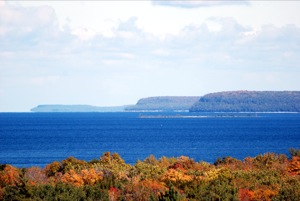
Courtesy Door Co. Visitors Bureau
“Perfect” is not a word that I that I am tempted to use often. But after a five-day trip in October, I found myself thinking that Door County, Wis., is as close to a perfect fall vacation spot as any destination could ever come.
Door County has made a name for itself as a summer destination, popular with residents of Chicago and other Midwestern cities, who make the trip up north to escape the heat. But in autumn, the county is absent the summer crowds and ablaze with fall color, and local farms and orchards bring in a harvest of apples and a host of other fruits.
I toured the peninsula as a guest of the Door County Visitors Bureau last fall and found the area rich with natural beauty, maritime history and a culinary culture that made it an ideal autumn getaway.
Beauty on the bay
Door County’s natural beauty is a function of its geographic location — if you can picture Wisconsin as a mitten, Door County is the thumb, a peninsula surrounded by the waters of Green Bay and Lake Michigan. A string of small towns line the 300 miles of coastline on this 70-mile-long peninsula, and although the area has become popular with tourists, 90 percent of its land mass remains undeveloped.
As a result, there are miles and miles of scenery to take in around the area simply while you drive from one place to another. When the highway winds through the forests, the autumn leaves create a blanket of color, both brazen and mellow; when it runs along the lakefront, passengers are treated to endless views of the deep blue waters.
I got my first introduction to the area’s surroundings on a Door County Trolley tour. Driver-guide John Berns took us to Peninsula State Park, a 4,000-acre nature preserve overlooking the bay, and told us about the secrets to the area’s natural beauty.
“We sit on a massive limestone ledge, on top of the Niagara Escarpment,” he told the trolleyful of passengers. “Whenever you come here, the gardens are in season. It’s not in spite of the limestone, it’s because of the limestone.”
A number of other parks in the area protect some of the peninsula’s most treasured ecosystems. At Whitefish Dunes State Park, thick forests lead to soft sands of a lakefront beach.
“It’s a forested sand dune — our beaches are covered with vegetation,” said the park’s Carolyn Rock. “We’re known for the most preserved sand dunes in the state of Wisconsin.”
In the summer, visitors treat the dunes like any other beach, enjoying a day in the sun and the water. During autumn, it’s too cold for swimming, but groups can take a guided nature walk along the dunes and in the forest areas behind them, which are thick with maples and American beech trees.
A museum at the park has exhibits about the area’s ecosystem, as well as some of the many Native American artifacts found around the dunes.
Adjacent to Whitefish Dunes is Cave Point County Park, another favorite natural spot for Door County visitors. The park’s name comes from the sea caves that have been carved out of the shore by the constant lapping of waves against the high rock walls. Adventurous groups can take guided kayak tours at Cave Point, paddling alongside the cliff and into some of the larger caves.
On the day of my visit, the waters were far too rough for paddling. A heavy wind off the lake whipped up large waves and sent them crashing into the rocks, making it easy to imagine how these caves had been formed over the centuries.
Although no one ventured near the water, the crashing waves and ensuing mist put on quite a show. Dozens of visitors stood atop the rocky outcroppings, where we could feel the vibrations in our feet when large waves thundered into the rocks beneath us.
Great lake, grand legacy
The lake and the bay that visitors enjoy today has also had a profound impact on Door County’s past. As in many other places on the Great Lakes, the shipping industry was historically very strong in Door County, and many places around the peninsula still draw on this economic and cultural history.
Door County’s name comes from the French nickname port de mort, or “death’s door.” The peninsula earned that title thanks to its rocky shoals and the sudden windstorms that made sailing in the area a treacherous proposition. Hundreds of ships were wrecked off the shores of Door County during the 19th century, and 10 historic lighthouses mark especially dangerous points around the coast.
The Cana Island Lighthouse is one of the most picturesque of the bunch and is open for visitors to tour.
“The tower is just as it was built in 1869,” site manager Dwight Zeller said as he led me around the lighthouse. “We’re a working lighthouse and a navigational aid. Some lighthouses are prettied up and made into a museum, but that’s not Cana. We’re a working lighthouse first and foremost.”
Visitors can climb the 97 steps to the top of the tower to see the light’s large lenses. In the daytime, the top of the tower also makes a wonderful sightseeing platform, giving a 360-degree view of miles of unspoiled forest and pristine lakes.
Groups with an interest in the area’s nautical past should also visit the Door County Maritime Museum in Sturgeon Bay. The museum has displays on the area’s lighthouses and shipbuilding industry, as well as the John Purves, an early-20th-century tugboat moored in the bay.
“It was built in 1919, and for 90 years it’s been floating,” said volunteer guide Mike Egan. “Her first job was down in the Caribbean as a radio ship. Her most exciting duty was in World War II, when she was a supply ship in the Aleutians.”
Museum guides take visitors onto the deck of the tug and below deck into the engine room, which was reconditioned by museum staff and volunteers over the course of more than five years. A tour of the boat also includes a look at the crew’s quarters, galley and mess area, where guides recount the impressive quantities of food fed to the men who used to work on board.
Falling for food
If there’s one great reason to visit Door County in the fall — besides the grand display of leafy color — it has to be the food.
Door County is one of the top cherry-producing areas of the country, counting some 2,000 acres of cherry orchards within its borders. The prime harvest season for these cherries is in July and early August, with 10 million to 15 million pounds of cherries picked during that time. However, there are plenty left over for great local dishes long into the fall.
Many of the same orchards that grow cherries also raise peaches and apples; during the autumn, honeycrisp, gala, golden delicious and Ida red apples are in their prime. At Seaquist Orchards, more than 130 bus groups each year come for a tour of the farm and a taste of the goodies made fresh in the onsite store.
During a driving tour of the orchards, family patriarch Dale Seaquist told me about all of the varieties of cherries and apples that his company grows and described many of the techniques used to produce the best fruit possible.
“This is a good place to raise fruit because of its proximity to the water,” he said.
After the tour, I took a spin through the farm store, sampling products such as cherry salsa, caramel apple fudge and fresh-from-the-oven apple cider donuts that were, without a doubt, the best I’ve ever tasted. On any given day, there will be 50 to 75 sample jars open at the store, giving visitors a great shopping — and snacking — experience.
Perhaps the most iconic of culinary experiences in the area is the Door County fish boil. Icelandic in origin, the fish boil was started on nearby Washington Island in the 1950s as a commercial venture. Today, it has become a staple of the tourist experience on the peninsula.
Several restaurants around the county offer fish boils. At the Old Post House where I sampled the fare, “Boil Master” Earl puts on a show for visitors, circling us around the outdoor fire and cauldron where the fish is boiled with salt, onions and potatoes. Once the fish is cooked and its oils rise to the surface of the cauldron, Earl throws some kerosene onto the fire, creating a spectacular flare-up as the fish oils spill down the side of the pot and into the flames.
Inside the restaurant, the fish came out soft and flaky, accompanied by the boiled potatoes, onions and drawn butter. The finishing touch — a slice of Door County cherry pie — made the perfect ending to a perfect autumn day.
For more Door County articles:
Picture perfect
Spend a day on Washington Island
‘Zips Ahoy!’
WEB EXCLUSIVE! Door County Photo Slideshow










